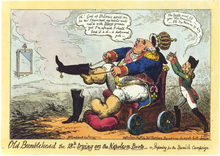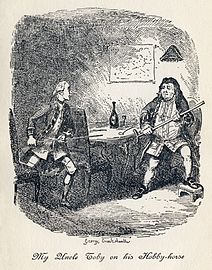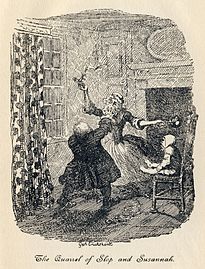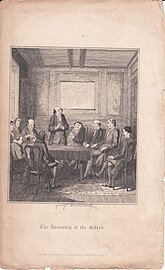George Cruikshank
George Cruikshank | |
|---|---|
 George Cruikshank, 1836 | |
| Born | 27 September 1792 London, England |
| Died | 1 February 1878 (aged 85) London, England |
| Nationality | British |
| Known for | Cartoonist (caricaturist), children's literature |
| Spouses | Mary Ann Walker
(m. 1827; died 1849)Eliza Widdison (m. 1851) |
| Partner | Adelaide Attree |
| Children | 11 |
| Parent(s) | Isaac Cruikshank Mary MacNaughton |
| Relatives | Isaac Robert Cruikshank (brother) |
George Cruikshank or Cruickshank (
Early life
Cruikshank was born in London. His father, Edinburgh-born Isaac Cruikshank, was one of the leading caricaturists of the late 1790s and Cruikshank started his career as his father's apprentice and assistant. His older brother, Isaac Robert, also followed in the family business as a caricaturist and illustrator.
Cruikshank's early work was caricature; but in 1823, at the age of 31, he started to focus on book illustration. He illustrated the first, 1823 English translation (by Edgar Taylor and David Jardine) of Grimms' Fairy Tales, published in two volumes as German Popular Stories.[1]
On 16 October 1827, he married Mary Ann Walker (1807–1849). Two years after her death, on 7 March 1851, he married Eliza Widdison. The two lived at 263
Cruikshank had fathered 11 illegitimate children with a mistress named Adelaide Attree, his former servant, who lived close to where he lived with his wife. Adelaide was ostensibly married and had taken the married surname 'Archibold'.[2]
Sociopolitical caricatures and illustrations

Cruikshank's early career was renowned for his social caricatures of English life for popular publications. He achieved early success collaborating with

Cruikshank replaced one of his major influences,

Etching, 1838
Charles Dickens

For Charles Dickens, Cruikshank illustrated Sketches by Boz (1836), The Mudfog Papers (1837–38) and Oliver Twist (1838). He also illustrated Memoirs of Joseph Grimaldi (1838), which Dickens edited under his regular nom de plume, "Boz". Cruikshank even acted in Dickens's amateur theatrical company.
On 30 December 1871, Cruikshank published a letter in
The friendship between Cruikshank and Dickens soured further when Cruikshank became a fanatical
In
She wore a large white cotton nightcap (on entering Ashenden has noticed the brown wig on a stand on the dressing-table) tied under the chin and a white voluminous nightdress that came high up in the neck. Nightcap and nightdress belonged to a past age and reminded you of Cruickshank's illustrations to the novels of Charles Dickens.
Temperance and the Volunteers
In the late 1840s, Cruikshank's focus shifted from book illustration to an emphasis on
When the invasion scare of 1859 led to the creation of the
However, Cruikshank received little encouragement from the Lord-Lieutenant of Surrey, and was rebuked for crossing into Kent to recruit. Disgusted, he disbanded his unit in 1862 and began anew in Middlesex, organising the 48th Middlesex RVC (Havelock's Temperance Volunteers). The unit ran into financial difficulties and when Cruikshank was forced to retire due to age, he was replaced as commanding officer by Lt-Col Cuthbert Vickers, a wealthy shipowner. However, the
The 48th Middlesex merged with the 2nd City of London RVC, also a working-men's unit, composed mainly of printers from the Fleet Street area, and the combined unit had a long history as the City of London Rifles.[10][11][12][13][14]
Later years


After he developed
In his lifetime he created nearly 10,000 prints, illustrations, and plates. There are collections of his works in the British Museum and the Victoria and Albert Museum. A Royal Society of Arts blue plaque commemorates Cruikshank at 293 Hampstead Road in Camden Town.[17]
Samples of his work
The Life and Opinions of Tristram Shandy, Gentleman
-
Plate I
-
Plate II
-
Plate III
-
Plate IV
-
Plate V
-
Plate VI
-
Plate VII
-
Plate VIII
Others
-
Westminster-Pit
1821 -
An unflattering 1819 caricature of thePrince Regent illustrating "The Political House that Jack Built" by William Hone
-
A Splendid Spread, early satire on thecrinolinefrom The Comic Almanack for 1850
-
George Cruikshank, Self-Portrait
-
Engraving of George Cruikshank
-
Humming-birds—or—a Dandy Trio. 1819.
-
Monstrosities of 1818, extravagant clothing styles of men's and women's fashions
-
A group of servants gathered in a kitchen, ape the manners of their employers
-
Caricature of the Old Bailey
-
Caricature concerning the prices at theCovent Garden Theatre
-
1813 caricature showing the Americans as cowardly in face of the British
-
Snuffing outBoney, 1814
-
December – A Swallow at Christmas (Rara avis in terris)
-
The Assembly of the Gifted
References
- ^ "Niamh Chapelle, 2001, p. 72" (PDF). Retrieved 22 November 2013.
- ^ a b John Wardroper (25 October 1992). "The secret life of a virtuous artist: John Wardroper turned sleuth to find the startling truth about George Cruikshank, illustrator and friend of Dickens, and a man revered as a stern moralist". The Independent. Retrieved 5 February 2013.
- Captain Marryat). See Temi Odumosu's article in The Slave in European Art: From Renaissance Trophy to Abolitionist Emblem, ed Elizabeth McGrath and Jean Michel Massing, London (The Warburg Institute) and Turin 2012.
- ^ Catalogue of the Collection of the Works of George Cruikshank, the Property of H.W. Bruton (of Gloucester). Sotheby, Wilkinson & Hodge. 1897.
- ISBN 9780299301644.
- ^ "The New Union Club, Being a Representation of what took place at a celebrated Dinner, given by a celebrated society | Royal Museums Greenwich". www.rmg.co.uk. Retrieved 21 November 2021.
- S2CID 246984311.
- ^ Gatrell, Vic. City of Laughter: Sex and Satire in Eighteenth-Century London. New York: Walker & Co., 2006
- ISSN 0007-1250.
- ISBN 0-85936-271-X, pp. 24–5, 45–6, 61 95 and Appendix VII.
- ISBN 978-1-84884-211-3, p. 179.
- ISBN 1-84342-170-4, pp. 1–3.
- ^ "Falling off the Wagon at Fusiliers Museum".
- ^ "Cuthbert Vickers probate, London Gazette 3 October 1922" (PDF).
- Sinclair, W.p. 468: London; Chapman & Hall, Ltd; 1909.
- ^ "Cruikshank's Grave Site on The Victorian Web". Victorianweb.org. 20 October 2006. Retrieved 22 November 2013.
- ^ "CRUIKSHANK, GEORGE (1792-1878)". English Heritage. Retrieved 23 October 2012.
Further reading
- Evans, Hilary and Mary. The Man Who Drew the Drunkard's Daughter: Life and Art of George Cruikshank, 1792-1878. (London: Frederick Muller, 1978).
- Cruikshank, George. Graphic Works of George Cruikshank (New York: Dover Publications, 1980) ISBN 0-486-23438-X
- George, Mary Dorothy. Catalogue of Political and Personal Satires Preserved in the Department of Prints and Drawings in the British Museum, vol. VI (1938), vol. VII (1942), vol. VIII (1947), vol. IX (1949).
- Bryant and Heneage. Dictionary of British Cartoonists and caricaturists 1730–1980 (Scolar Press, 1994).
- Buchanan-Brown, John. The Book Illustrations of George Cruikshank Charles Tuttle 1980
- Cohn, Albert M. "George Cruikshank: A Catalogue Raisonne of the Work Executed During the Years 1896–1977", Bookmans journal (London, 1924).
- Bates, William. George Cruikshank: The Artist, the Humourist, and the Man, with Some Account of his Brother Robert. A Critico-bibliographical Essay (Amsterdam: Emmering, 1972)
- Price, Chris. "'Pictorially Speaking, so Ludicrous': George IV on the Dance Floor", Music in Art: International Journal for Music Iconography XLIII/1-2 (2018), 49–65.
External links
- SurLaLune Fairy Tale Pages: Fairy Tale Illustrations of George Cruikshank Archived 16 July 2012 at the Wayback Machine
- George Cruikshank cartoons at CartoonStock (Commercial site)
- Online Gallery of Illustrations by George Cruikshank
- George Cruikshank letters, 1845 and 1868 from the Woodson Research Center at Rice University
- Patten Research Material on George Cruikshank from the Woodson Research Center at Rice University
- "Archival material relating to George Cruikshank". UK National Archives.
- Works by George Cruikshank at Project Gutenberg
- Works by or about George Cruikshank at Internet Archive
- Works by George Cruikshank on Flickr Commons
- George Cruikshank at Comiclopedia
- Guide to the George Cruikshank Etchings. Special Collections and Archives, The UC Irvine Libraries, Irvine, California.
- Chisholm, Hugh, ed. (1911). . Encyclopædia Britannica. Vol. 7 (11th ed.). Cambridge University Press. pp. 523–524.
- George Cruikshank at Library of Congress, with 632 library catalogue records






















